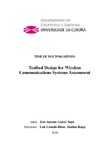Testbed design for wireless communications systems assessment

Use este enlace para citar
http://hdl.handle.net/2183/12390Colecciones
- Teses de doutoramento [2227]
Metadatos
Mostrar el registro completo del ítemTítulo
Testbed design for wireless communications systems assessmentAutor(es)
Directores
Castedo, LuisRupp, Markus
Fecha
2010Centro/Dpto/Entidad
Universidade da Coruña. Departamento de Electrónica e SistemasResumen
[Abstract] Since Marconi succeeded in carrying out the first wireless transmission in 1894, experimental
research has been always linked with wireless communications. Today, most wireless
communications research relies only on computer simulations. Although computer simulations
are necessary and recommendable for wireless systems evaluation, they only reflect the
simulation environment rather than the actual scenarios in which wireless systems operate.
Consequently, it is desirable to assess wireless communications systems in real-world scenarios
while, at the same time, keeping the required effort within reasonable terms. Among the
different strategies suitable for undertaking such assessment, the testbed approach constitutes a
simple and flexible enough solution based on the software-defined radio concept in which only
the fundamental operations (usually the transmission and the acquisition) are carried out in realtime,
while the remaining tasks are implemented off-line in high-level programming languages
(e.g. MATLAB) and using floating point operations. The testbed approach leads to a suitable
solution in terms of cost, manpower and a priori knowledge, making them affordable for small
research groups with scarce resources, as in our case.
In this work we introduce the GTEC MIMO testbed, which is just another multiple antenna
wireless testbed based on commercial off-the-shelf hardware modules. We complement the
hardware equipment with a software architecture designed to ease the utilization of the testbed
as well as to simplify the software needed for the measurement process. Making use of the
GTEC MIMO testbed we carried out several measurement campaigns in indoor scenarios with
the objective of exploring the feasibility of blind estimation techniques of the wireless channel
in Alamouti coded systems; assessing state of the art channel codes as the Serially-Concatenated
Low Density GeneratorMatrix (SCLDGM); and evaluating analog joint source-channel coding.
Thanks to the collaboration with the Institute of Communications and Radio-Frequency
Engineering at the Vienna University of Technology, we also assessed mobile communications
systems in very realistic, outdoor, urban scenarios making use of the Vienna MIMO Testbed.
More specifically, we evaluated the performance of High-Speed Downlink Packet Access
(HSDPA) by measuring the actual throughput of the physical layer downlink and comparing
it with the estimated channel capacity as well as with the estimated maximum attainable
throughput according to the HSDPA standard.
Palabras clave
Comunicaciones móviles
Derechos
Os titulares dos dereitos de propiedade intelectual autorizan a visualización do contido desta tese a través de Internet, así como a súa reproducción, gravación en soporte informático ou impresión para o seu uso privado e/ou con fins de estudo e de investigación. En nengún caso se permite o uso lucrativo deste documento. Estos dereitos afectan tanto ó resumo da tese como o seu contido Los titulares de los derechos de propiedad intelectual autorizan la visualización del contenido de esta tesis a través de Internet, así como su repoducción, grabación en soporte informático o impresión para su uso privado o con fines de investigación. En ningún caso se permite el uso lucrativo de este documento. Estos derechos afectan tanto al resumen de la tesis como a su contenido





